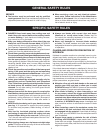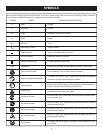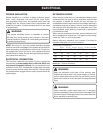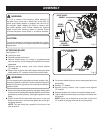
4 5
SPECIFIC SAFETY RULES
WARNING:
Some dust created by power sanding, sawing, grinding, drilling, and other construction activities contains chemicals
known to cause cancer, birth defects or other reproductive harm. Some examples of these chemicals are:
• lead from lead-based paints,
• crystalline silica from bricks and cement and other masonry products, and
• arsenic and chromium from chemically-treated lumber.
Your risk from these exposures varies, depending on how often you do this type of work. To reduce your exposure to
these chemicals: work in a well ventilated area, and work with approved safety equipment, such as those dust masks
that are specially designed to filter out microscopic particles.
n Do not use dull or damaged blade. Unsharpened or
improperly set blades produce narrow kerf which causes
excessive friction, blade binding and KICKBACK.
n Blade depth and bevel adjusting locking levers
must be tight and secure before making cut. If blade
adjustment shifts while cutting, it may cause binding and
KICKBACK.
n Use extra caution when making a “Pocket Cut” into
existing walls or other blind areas. The protruding blade
may cut objects that can cause KICKBACK.
n Know your power tool. Read operator’s manual care-
fully. Learn its applications and limitations, as well
as the specific potential hazards related to this tool.
Following this rule will reduce the risk of electric shock,
fire, or serious injury.
n Always wear safety glasses. Everyday eyeglasses
have only impact-resistant lenses; they are NOT safety
glasses. Following this rule will reduce the risk of serious
personal injury.
n Protect your lungs. Wear a face or dust mask if the
operation is dusty. Following this rule will reduce the
risk of serious personal injury.
n Protect your hearing. Wear hearing protection during
extended periods of operation. Following this rule will
reduce the risk of serious personal injury.
n Inspect tool cords periodically and, if damaged, have
repaired at your nearest authorized service center.
Constantly stay aware of cord location. Following this
rule will reduce the risk of electric shock or fire.
n Check damaged parts. Before further use of the
tool, a guard or other part that is damaged should
be carefully checked to determine that it will operate
properly and perform its intended function. Check for
alignment of moving parts, binding of moving parts,
breakage of parts, mounting, and any other conditions
that may affect its operation. A guard or other part that
is damaged should be properly repaired or replaced
by an authorized service center. Following this rule will
reduce the risk of shock, fire, or serious injury.
n Make sure your extension cord is in good condition.
When using an extension cord, be sure to use one
heavy enough to carry the current your product
will draw. A wire gage size (A.W.G.) of at least 12 is
recommended for an extension cord 50 feet or
less in length. A cord exceeding 100 feet is not
recommended. If in doubt, use the next heavier gage.
The smaller the gage number, the heavier the cord. An
undersized cord will cause a drop in line voltage resulting
in loss of power and overheating.
n Inspect for and remove all nails from lumber before
using this tool. Following this rule will reduce the risk of
serious personal injury.
LASER GUIDE WARNINGS:
The laser guide radiation used in the Ryobi circular saw is
Class IIIa with maximum <5mW and 650nm wavelengths.
These lasers do not normally present an optical hazard
although staring at the beam may cause flash blindness.
n Avoid direct eye exposure when using the laser guide.
n The laser shall be used and maintained in accordance
with the manufacturer’s instructions.
n Never aim the beam at a person or object other than the
workpiece.
n Always ensure the laser beam is aimed at a sturdy
workpiece without reflective surfaces. Shiny reflective
sheet metal or similar shiny materials are not suitable for
laser use.
n All repairs should be made by an authorized service
representative or the laser manufacturer.
n Save these instructions. Refer to them frequently and
use them to instruct others who may use this tool. If you
loan someone this tool, loan them these instructions
also.


















